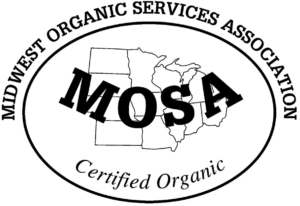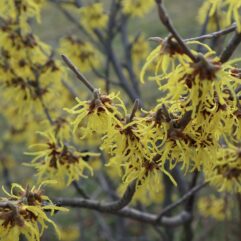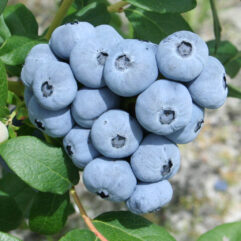

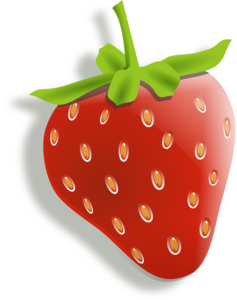
Description of Strawberry Cultivars
All strawberry plants are 100% certified organic and non-GMO.
They are grown here on our farm and are free of any chemicals.
All strawberry plants are sold as well-rooted, quart-size plants.
No blossom trimming is required on our plants as they arrive with a
strong, functional root system ready to support berry production.
All strawberry orders have free shipping, and can be located in the shop by selecting the Strawberry Category. Not all cultivars below are for sale, these are just the ones we grow. They are all located in one place so you can read about their differences.
You can also click here to take you to the Strawberry Offers.
The Strawberry Offers page will show what cultivars are for sale. If they are not listed for sale, they are currently sold out.
NOTE: Some of our “June” types are out of stock until mid to late May 2022. We do have some cultivars available now, though, and also alpine strawberries. They are all potted and can be planted anytime of the year. They do not need to be planted in the early spring like bare root strawberry plants.
Categories:
Alpine Strawberry
Day Neutral Strawberry
“June”-bearing Strawberry
ALPINE STRAWBERRY CULTIVARS
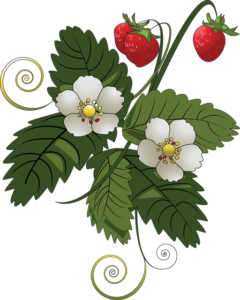
Alpine Strawberry plants are originally from the mountains and valleys of the Alps across France and Italy and other countries following the southern boundary of those mountains. They grow well in USDA zones 4-9, and can handle cooler locations if they have winter protection. Berries are small, elongated, and very richly flavored. I find the yellow to white cultivars to have the most intense flavor and sweetness. Plants do not (usually) runner, except for Attila; instead forming a mounding plant that grows very large over the first couple years. Clumps can be divided every few years to increase plantings and keep berry yields robust. A mature clump of alpine strawberry is as productive as our more traditional larger strawberry cultivars.
Alexandria
Organic Red Alpine Strawberry
Fragaria vesca (OP seed grown)
Heirloom cultivar.
Alexandria produces long, red berries of exceptional flavor, averaging 1″ long by 1/2″ wide. The plants bloom from early spring through fall, and with protection from frosts, into early winter (yield will get smaller as cooler weather and shorter days urge the plant to go dormant). The plants are runnerless, forming a foot wide plant at maturity with many crowns (which can be separated for starting new plantings). Alexandria does well in pots and small garden areas, and with no runners, one doesn’t have to worry about it spreading into other locations. Like most Alpines, Alexandria is very disease resistant, and I have never had to use any organic controls on it or Yellow Wonder. Best yields have been obtained in raised beds and potted growing.
USDA hardiness zones 4-9
Yellow Wonder
Organic Yellow Alpine Strawberry
Fragaria vesca (OP seed grown)
Heirloom cultivar
This is the first Alpine I ever grew, over 12 years ago. It is one of the most flavorful strawberries I (and my kids) have ever eaten. As they have gotten older and more adept at picking berries, it is a rare treat for me to actually find one on the plants they have picked over. When fully ripe, they are extremely sweet and aromatic (like most alpines), with hints of sweet pineapple as an undertone. Berries are longer than they are wide, averaging about 1″ long by 1/2″ wide, and are prolific on a mature plant. Mature plants get over a foot wide, are runnerless, and yield from mid-spring through the late fall. They will stop flowering when temps get over 86 degrees F, so a little shade in the hottest parts of summer will keep them producing for most of your growing season. If they do get too hot, they will resume flowering when daytime temps consistently fall below 86. Excellent for pots, square foot gardens, and hanging baskets. Plants are long-lived, and crowns can be divided for propagation after a few years.
USDA hardiness zones 3-9
Red Wonder
Organic Red Alpine Strawberry
This alpine was selected for a more compact shape and has a great production of red, alpine strawberries. Great for pots (at least a 2 gal size will provide good room for growth over a couple years, then plants can be divided) and raised beds where they thrive. Berries are shorter than Reine des Vallees or Mignonette, but prolific, especially when the plant is fed well. Red Wonder ripens slightly later than most of the other cultivars, though in the same general time frame. This cultivar does not produce runners.
Hardy in USDA zones 4-8
White Soul
Organic White Alpine Strawberry
White Soul has a very pale yellow to primarily white berry. While we associate the lack of rich color with the lack of flavor, this assumption is not true with the white alpines. White Soul, similar to Vanilla, has very aromatic berries with rich strawberry/pineapple mix of flavor, very sweet. This cultivar is also a compact form, though most alpines tend to be mounding plants and are tidy as a rule. White Soul adds another mark of diversity in the alpine strawberry world, and I have been pleased with its growth and yield here on our farm in its first season. White Soul does not produce runners.
Hardy in USDA zones 4-9
Vanilla
Organic Yellow/white Alpine strawberry
This yellow/white alpine cultivar is productive and very tasty, having the same complex and aromatic flavor found in Yellow Wonder or Pineapple Crush. Berries are slightly shorter than Yellow Wonder, more rounded but still having the elongated shape of the traditional alpine berry.
Follow the same growing recommendations for the alpines described in the above cultivar descriptions. Plants are mound forming, and are runnerless. Set them a minimum of 12″ on center. Like all alpines, these can be divided after a few years, and are long lived.
USDA hardiness zones 4-9
Etiole Jaune
Organic Yellow/pale yellow Alpine strawberry
Etiole Jaune (Yellow Star) is a relation to Yellow Wonder, but selected in a different part of Europe’s alpine regions. EJ is slightly smaller and less high yielding than Yellow Wonder, but offers another distinct and tasty version of the light colored alpines. My children find the yellow alpines to have the most pleasing flavor of any strawberry, and they like the pale color as it is so different from their expectations. EJ is runnerless, and will remain in a tidy mound that can be divided every few years to create new clumps. EJ may also have slightly better resistance to foliage diseases than other alpines, but the past two years of watching it have shown it to be a vigorous grower and consistent yielder.
USDA hardiness zones 4-9
Pineapple Crush
Organic Yellow/pale yellow Alpine strawberry
Pineapple Crush is a more recent selection of the pale yellow alpine strawberry. The seed line has been maintained by the Strawberry Seed Store in Delaware for many years, and we are proud to offer this great cultivar for sale in 2018. Pineapple Crush has a very high yield for an alpine, with excellent sweetness and strawberry aroma you can smell as you lean down to pick the berries. Size of berry is larger than any of the other yellow fruited cultivars. This has been an enjoyable cultivar the past 4 years on our farm, and I have been able to watch it grow and produce. Given enough space, it will yield copious amounts of alpine strawberries for many years.
USDA hardiness zones 4-9
Mignonette
Organic Red Alpine Strawberry
Mignonette is an older red alpine cultivar which as a very sweet taste and long, 1″ berries that have the standard alpine look (being longer than they are wide). An established alpine producer noted that the flavor of Mignonette may be the sweetest of all the red alpine types. In my experience, it has been comparable to Alexandria, both in yield and flavor, though Mignonette’s berry sometimes runs a bit larger than Alexandria. This is another great addition to the alpine strawberry plants we sell. See Alexandria or Yellow Wonder descriptions for specific spacing and requirements for all alpine strawberries.
USDA hardiness zones 4-9
Reine des Vallees
Organic Red Alpine Strawberry
The name is French and means Queen of the Valleys. This old, European cultivar is the leading producer in Europe for alpine strawberries, and has shown excellent production here in the US. Productivity seems to be as high as Alexandria, with excellent flavor and berry size. This addition brings more diversity to our red alpine strawberry cultivars. Another worthy red alpine to add to your collection of highly productive plants.
USDA hardiness zones 4-9
Fragola Quattro Stagioni
Organic Red Alpine Strawberry
This red, Italian alpine’s name translates as 4 Season Strawberry. Berries are red, good size for an alpine, more rounded than in Alexandria but still with the classic alpine appearance. Flavor is excellent as it is with most all alpine cultivars I’ve trialed and tasted. Our kids love all strawberries, but the alpines still remain the most sought after as they ripen. Mature plants get over a foot wide, are runnerless, and yield from mid-spring through the late fall. This is the third addition of red alpines we are introducing as the first, certified organic alpine strawberry plants available in the US. It is very amazing to see the same diversity in these alpines as one sees in the June bearing types with which we are all so familiar. I feel this genetic diversity suits the organic grower, as it lends more leverage against the whiles of the weather and pests. Having a wider diversity of cultivars in one’s plantings allows for a greater insurance that a crop will come through.
Quattro is hardy in
USDA zones 4-9
Attila
Organic Red Alpine Strawberry
Attila is one of only a few alpine cultivars that runners vigorously similar to the June bearing strawberries we are all familiar with in the US. The attraction of this is that Attila is also a producer of delicious red alpine berries, and it can spread out over an area, creating an edible ground cover or bed. Thinning for high fruit quality is still recommended, but if you are looking for a tasty alpine to take over an area, Attila is it (I think it got its name from the conqueror of the 5th century; but only from the way it spreads, because this strawberry is all about alpine berry-love). A great addition to any alpine berry garden. Day-neutral and season long yield as other alpines provide.
USDA hardiness zones 4-9
Fragola di bosco
Organic Wild Red Alpine Strawberry
This is an wild, collected-from-the-wild (Italian alps) alpine. Most alpines are, but this one is from a seed source that is variable and across a wide range of locales. This means that berries may vary in size from plant to plant, but also that the uniqueness of these is in their diverse genetic range. They have been growing here at the nursery and look great, healthy and able to take our summers well. This is one strawberry I don’t grow the seed for, as I prefer to get it directly from Italy to maintain the wide geographic collection range. This will have more variable fruit size, though the flavor has been very good and to me indistinguishable from other red alpines. They are smaller berries overall when compared to the other red alpines, but they show the same vigor and growth of all alpines.
USDA hardiness zones 4-9
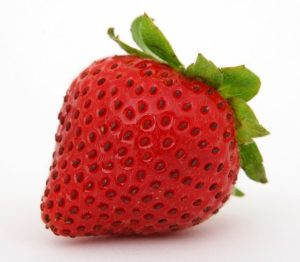
Day Neutral Cultivars
Seascape Organic Strawberry
Developed in 1991 by the University of California, Seascape has had great success outside the Golden State. Of the day-neutral introductions that I’ve trialed on our farm, Seascape has consistently had the sweetest flavor for a full-sized, red strawberry, and better production. Berries are large and deep red. I’ve had Seascape in production on our farm for over 9 years now, and I can’t see replacing it with any other cultivars. Like all day-neutral strawberries, a little shade in the high heat of summer really helps keep production and fruit quality at its highest. Spacing of at least 12″ apart, and up to 24″ apart, helps to control disease in the mid to late summer if wet, warm weather hits.
USDA hardiness zones 4-9
San Andreas Organic Strawberry
San Andreas was released in 2009 by the University of California. It ripens earlier than Seascape, with a medium to large berry of light red color. The berry tends to be longer than wide. Much sweeter than Albion, and tolerates our spring wet weather and summer humidity much better than Albion. Productive and has 3 fruiting seasons during our growing year (spring, mid-summer, and late Fall). I have been impressed with San Andreas’ ability to deal with humid weather and rain. It has successfully made summer crops when other day-neutral types failed to deliver. This is a good addition to the day-neutral line-up for reliability and sweet berries.
USDA Hardiness zones 4-9
Albion Organic Strawberry
Released in 2004 by the University of California, Albion is a modern day-neutral cropping on 4-6 week intervals from late May until the first frosts. I’ve found that it does best in raised beds, and regular feeding is essential for good sized berries. Albion comes in with some new resistance, and has shown itself to be very productive in 2015, doing well with cropping despite the heavy rain and moisture levels. U of C breeders have found Albion is resistant to verticillium wilt, phytophthora crown rot, and anthracnose crown rot. In this wet year of 2015 it has done well with the first cropping, holding up better than any of the other day-neutrals (the alpines did well in the wet weather as well). Berry is large for the first cropping (June), with medium-large berries for the remainder of the cropping year. Very sweet unless a lot of rain has fallen (just impossible to maintain full sweetness in the presence of 10+ inches a week), full red, with no green shoulders when ripe.
USDA hardiness zones 4-8
Fort Laramie Organic Strawberry
Released 40 years ago by the USDA station in Cheyenne, WY, this near-heirloom strawberry has kept its place in the ranks of newer cultivars due to its cold-hardiness and ability to produce fruit in very tough environments. While it is a day-neutral type, it belongs to the first generation of those strawberries, which are known as “ever-bearing”.
Fort Laramie produces medium to large berries (larger with good fertility) with a bright scarlet color, very sweet, showing exceptional resistance to fruit rots here at our farm in Indiana (performing better than Ozark Beauty).
Fort Laramie bears a large, early crop just before or with our first June-bearing types; with another crop in late summer. Berries on older plants are also produced sporadically through the summer, especially if runners are kept pruned (the spring runners on a 2 year plant will actually fruit in the summer, though the berries are on the small side for that crop). This is a very rugged cultivar, hardy to zone 3 and the cooler areas of zone 8. Originally bred with the mountain west in mind, Fort Laramie has done reliably well across the U.S., and continues to enjoy popularity for the ease of its growth and the production of quality strawberries under adverse conditions.
USDA hardiness zones 3-8a
Ogallala Organic Strawberry
This 1956 introduction by the USDA had one parent that was a wild strawberry from the Rockies. Like Fort Laramie, Ogallala is very tolerant to far northern cold and elevation. It has a sometimes variable shaped strawberry, being elongated to conical, bright red, and a fine sweetness similar to alpine strawberries. It is not a modern day-neutral, and bears two crops a year: one in June and again in late August to early September (for zone 5). My oldest daughter finds this to be the tastiest of the “traditional” red strawberries, as it has that hind of alpine in it (which is her favorite).
USDA hardiness zones 3-9a
Sequoia Organic Strawberry
Especially suited for California, Pacific and Gulf Coasts
This cultivar is listed with the day-neutrals, but this trait in Sequoia is only expressed in the warmer locales of the U.S., such as southern and coastal CA, the Gulf Coast, and lower Atlantic seaboard (Wilmington,NC south to Daytona, FL). Sequoia is cold hardy to zone 5, but will perform as a June-bearing type when grown in the colder regions of its hardiness zones. It is noted repeatedly for its excellent performance in California and the Pacific Coast. Here in IN it has performed well with the June-bearing cultivars, and makes a large to very large, sweet strawberry that is very red. Sequoia has definitely performed better in raised bed culture here at our farm.
USDA hardiness zones 5-9b
“June-bearing” (early summer) cultivars
Cultivars are listed in sequence of ripening
Wendy
Organic Early Season Strawberry
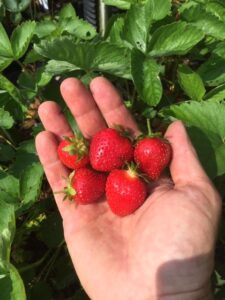
Wendy is a very early-season producer of consistently large, sweet strawberries. This cultivar is very early to bloom, and in our frosty valley I always have some freeze blankets ready for covering the blooms. I’ve had excellent production after late April temps in the mid 20’s, as long as I kept the beds covered with 3 oz freeze blanket (you can also double up 1.5 oz to gain that benefit). Freezes below that temp saw some loss of production, but the berry size was large and excellent. Wendy was developed at the Kentville Research Station in Nova Scotia, and is very winter hardy (I always keep our beds covered overwinter with freeze blankets, as we often don’t get enough snow cover; it also keeps deer and rabbits from chewing the crowns off).
Wendy has shown good disease resistance in our plantings; and keeping good spacing between plants, and the bed thinned, keeps the berries large and sweet.
This is the earliest producing June-type I’ve grown, and is far and away better flavored than Earliglow (in my opinion).
Hardy in USDA zones 3-8
Annapolis
Organic Early Season Strawberry
Originally bred in Nova Scotia, in 1984, Annapolis is a very early ripening strawberry that I have found (here at our farm) to have better flavor and larger size than Earliglow . Berries are consistently large throughout the picking cycle, and have a bright red color and rich sweetness, especially in warmer springs. Annapolis is vigorous and cold hardy, and has been one of the most reliable and consistent early strawberry cultivars I have grown. Noted for its resistance to red stele.
USDA hardiness zones 3-8
Honeoye
Organic Early Season Strawberry
Released in 1979, in New York, Honeoye is still one of the most widely planted early season strawberries in the Midwest. The simple reason is flavor and production: large, red, sweet berries on very vigorous plants that runner well. It is also one of the most winter hardy cultivars available.
I have found that all strawberries perform better in raised beds, especially if your native soil is on the heavier, clayey side. With heavy soils, Honeoye tends to be less sweet and lower yielding. The lighter, fluffier, better drained soils in raised beds offer the best production and flavor for Honeoye.
USDA hardiness zones 3-8
Red Chief
Organic Early-Mid Season Strawberry
Heirloom
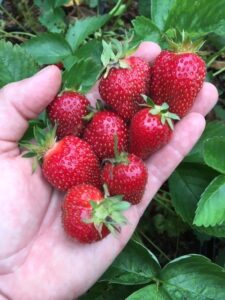
Released by the USDA’s Beltsville Research Station in 1968, Red Chief became one of the East’s most planted cultivar for commercial production. It is a rugged plant that has a proven history of production in the U.S., and is still planted today, though in much reduced numbers (strawberry production has also vastly changed from when I was a child, with the predominance of the crop now being in CA). The main reduction in its planting is that the berry size is now considered medium to medium-large. The strawberries are very sweet, and firmer than Sparkle. Red Chief has excellent resistance to Red Stele, and shows very little effect from any leaf diseases. This cultivar is widely adapted to the U.S. climates, and will perform in all but the hottest zones of our country.
USDA hardiness zones 3-9a
Yambu
Organic Early Mid-Season Strawberry

Yambu is a new cultivar to the US that I have been trialing at our farm here in Indiana for the past two years. It was first selected in the Netherlands in 2003 (from a cross made in 2001) by Fresh Forward.
It ripens a little after or concurrently with Honeoye, which is still seen as the measure of strawberry success here in the Midwest (especially for organic growers).
What I’ve found in the short time I’ve grown it is this: it has a nice large berry that is very sweet despite some adverse weather over the past two harvest seasons. Yambu has a slightly longer harvest time compared to Honeoye, but the two are very compatible in vigor and yield. Honeoye is one of Yambu’s parents, so this similarity is not unexpected. The berry of Yambu is a little firmer than Honeoye, and seems to have fewer seeds on the berry. Diversity is a great thing to have in the organic garden, and I have been very pleased with Yambu’s performance so far.
USDA hardiness zones 4-7
Cavendish
Organic Early Mid-Season Strawberry
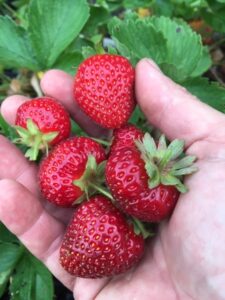
From Nova Scotia in 1990, Cavendish has Annapolis as one of its parents. Very cold hardy cultivar, it also produces large, dessert quality strawberries that are firm and very sweet. My kids love to pick these and carry them around as they eat them, and there is something just wonderful about biting into a huge, sweet strawberry. Cavendish also takes a longer time to ripen its whole crop, so you can get fresh strawberries over a little longer period with them than most other cultivars. With proper feeding and irrigation, large berry size remains consistent during the long harvest cycle. Plants also runner strongly, and have a good resistance to red stele and Verticillium wilt.
USDA hardiness zones 3-7
Guardian
Organic Mid-Season Strawberry
1969 release by USDA in Beltsville, MD. Guardian was the first cultivar to have wide resistance to many common and difficult strawberry diseases such as red stele, verticillium wilt, leaf scorch and powdery mildew, as well as some viruses. Very large to large berries are scarlet red, very sweet, firm and juicy. Berries can be picked over a
2-3 week period. This was another surprise in our 2012 trials (I trialed a number of old time cultivars), and given the late freeze, along with the dry Spring and early heat, Guardian performed at the top in flavor and yield. The one drawback to this cultivar is berry color, which is not as deep red as we’ve come to expect. Even though lighter colored (which is why it was dropped from commercial use), the flavor is very sweet. My daughters and son had no trouble devouring the berries last summer, and I’m increasing our strawberry production areas with Guardian.
I’d suggest some extra protection (like a freeze blanket) for USDA zone 4
USDA hardiness zones 4-8
Mesabi
Organic Mid-Season Strawberry
Backyard Berry Plants Exclusive cultivar
Introduced by the U of MN and USDA breeding cooperative.
Very cold hardy cultivar with bright scarlet berries. The berries have been large sized for us, with only a small portion of the later ripening berries being a bit smaller. Flavor of the berry grown in raised beds and pots has been very sweet when full red, and mildly sweet and spritely at the pink stage (not unusual for home-grown strawberries). My kids often can’t wait to eat the berries as they watch them ripen, and often just eat them when they are pink with a lot of white still near the stem end. Mesabi they noted were “good enough” to eat, so why wait? I have not only to worry about birds and chipmunks, but now my kids are eating them before they ripen!
Mesabi has been a real treat to grow, as it ripens in a window that is usually lacking strawberries for us at that time in June. Has shown good resistance to leaf diseases, no berry rot (again, the raised bed is helping this), and is a vigorous producer of runners.
USDA hardiness zones 3-7
Cardinal
Organic Mid-Season Strawberry
Released in 1974 by the Arkansas Ag Exp. Station. Cardinal does well throughout the Southern states, and into the Ohio River Valley (So. Illinois, Indiana, Ohio, Pennsylvania). Bred for tolerating humid summers, Cardinal has resistance to leaf scorch, leaf spot, and powdery mildew. The berries are very large, red (sometimes a very slight green tip), firm, and very sweet. Cardinal runners heavily, so be sure to keep them trimmed to prevent over crowding of the bed. This cultivar has a long picking season, with berries ripening over a longer period of time (can be up to 4-5 weeks on mature plants) than most other June-types. I trialed my first crop in 2012, and was very impressed with the flavor of this old-time cultivar. This is our agricultural heritage, and I’m glad to be maintaining one of our country’s older, reliable producers. Can be grown in USDA zone 4 with extra protection over winter.
USDA hardiness zones 5-9
Tennessee Beauty
Organic Late Mid-Season Strawberry
Heirloom
From Tennessee in 1949 by Dr. E.M. Henry, Beauty is still around for home gardeners due to its reliability and flavor. This heirloom cultivar has a longer picking season (something that caused it to lose popularity in commercial harvesting) and very good resistance to strawberry viruses. The berry size is large, with a high cap (easy to pop off for freezing and canning), deep red color, and very sweet. Towards the end of the picking season, berry size drops to medium, but flavor and taste remain the same. Large berries make up 70% of the total crop. Good fertility and irrigation during dry spells (esp. during the summer when it is initiating flower buds for next years crop) keeps yield high for Tennessee Beauty. This strawberry was bred with the lower Midwest springs in mind: wet, humid, and stormy. Does well in all the Southern states, as well as Indiana, Ohio, Pennsylvania, Missouri, the lower New England states, Oklahoma, and Texas (these two states pay extra attention to irrigation). Can be grown in zone 4 with extra winter protection.
USDA hardiness zones 5-9
Cabot
Organic Late Mid-Season Strawberry
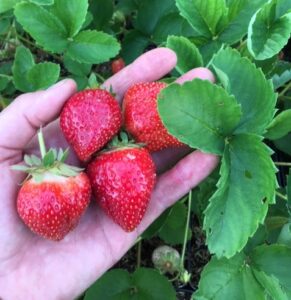
A Canadian release (Kentville, Nova Scotia) in 1998, Cabot has two outstanding traits: extremely large berries with sweet flavor; and strong resistance to fungal infections on foliage and roots. Descended from cultivars such as Micmac, Kent, Earliglow and Bounty, this cultivar has a strong history of performance on the Atlantic Coast and interior Eastern US. Cabot grows vigorously and has a nice, large size; but it has a lower runner production. This means there is less thinning required when growing Cabot. In wet weather, the first large fruits can crack; but the majority of the crop will maintain firmness and sweetness. As with all strawberries, consistently wet, cold, cloudy weather can dilute flavor. Here at our nursery, Cabot consistently shows each year the steady production of sweet tasting, large berries; and in a no-spray system as well.
USDA hardiness zones 4-7
Sparkle
Organic Late Mid-Season Strawberry
Heirloom
Bred by J.H. Clarke of Rutgers University, NJ, in 1942.
Sparkle used to be a leading late-season cultivar, and like many old-time cultivars, it had great flavor and high yields. But the berry size was considered too small compared to new introductions, so Sparkle was relegated to small growers who still served what the local people wanted. Sparkle’s berry size is considered small to medium by modern standards, and the fruit is medium firm with a rich, aromatic strawberry flavor. The yield is also very high, usually out-producing modern cultivars in yield per area. As Sparkle has a powerful runner potential, one needs to keep the planting area thinned of excessive new plants. This will keep overall yield in the high range, as overcrowding of plants can cause a decrease in yield (strawberries are often their own worst weed). Sparkle has resistance to some strains of red stele, but I have had no issues with any disease when they have been grown in raised beds or large pots.
USDA hardiness zones 3-8
Valley Sunset
Organic Late Season Strawberry
Sunset is yet another successful release from the Kentville Experiment Station in Nova Scotia. The strawberries are light, blushed red; and are large, sweet, and not too firm (not the best for shipping, but excellent for fresh picking and eating). Sunset ripens later in the strawberry season, and has been one of the latest to ripen on our farm here in Indiana (Record has been consistently the latest, with Sunset and Sparkle preceding it most years). Sunset’s foliage is noted for its high resistance to fungal and bacterial pathogens that can reduce growth and yield in strawberries. A moderately winter hardy cultivar, Sunset has always done well for us (since 2011) in our zone 5 climate when properly protected from sub-zero freezing winter weather.
USDA hardiness zones 4-7
Record
Organic Late Season Strawberry
Bred and selected in Forli, Italy, by Dr. Faedi. Record is the latest ripening, June-bearing strawberry available at this time. I began growing this one in 2012, and was very impressed with the quality of fruit, and sweetness. In 2012 it was really hot, and it did not seem to negatively affect Record berries at all. Berries are medium to large sized, prolific, very sweet, and bright red.
USDA hardiness zones 4-8
